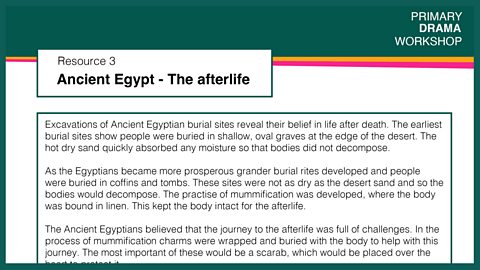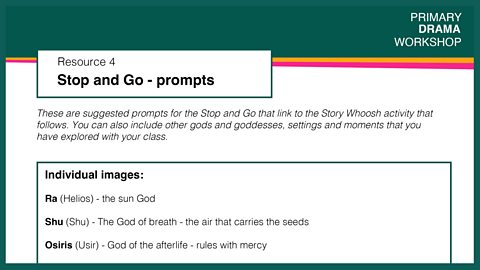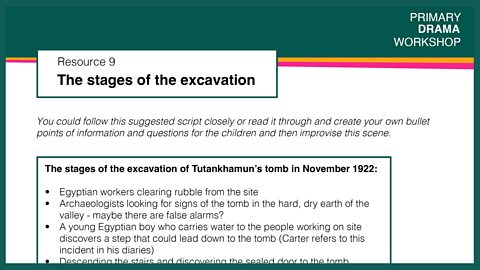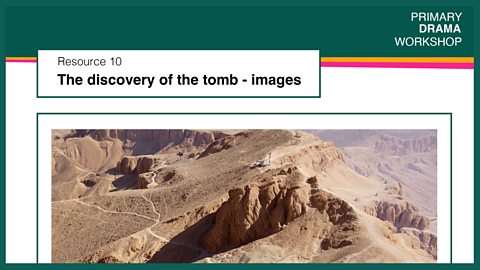The third film offers strategies for bringing a drama to its conclusion, using as the context the history topic Ancient Egypt and the discovery of the tomb of Tutankhamun in particular.
The video

3. Concluding a drama
The third and final video follows an upper KS2 class and their teacher in London as they work their way through Session 3 of .
Sessions 1 and 2 of the framework pupils explore beliefs about Ancient Egyptian deities and begin to assume the role of archaeologists in The Valley of the Kings. In the film covering Session 3 of the framework the pupils:
- Explore the tension between the drive for knowledge of the archaeologists and the beliefs and funerary rites of the Ancient Egyptians
- Have the freedom to express what has interested them in the drama work in a final scene making activity.
The drama strategies demonstrated in the film are:
- Five point narrative: pupils make a sequence of five still images showing the discovery of the tomb and then sequence the still pictures in time to music
- Conscience alley: one pupil takes on the role of the archaeologist and walks down an 'alley' created by other members of the group, who speak the archaeologist's innermost thoughts at a key moment of the drama
- Scene making - dream sequence: pupils work in groups to show a dream sequence which incorporates content and strategies of their own choosing.
More information on the drama strategies used in the film can be found in and in the .
Duration: 13' 30"

Resources
The framework pdf documents include hyperlinks to the individual resources. For best performance it is strongly recommend that you download the framework pdf and then open it using a suitable program - such as Acrobat - rather than using the framework in your browser.
Exploring the KS2 history topic Ancient Egypt. Accompanies Film 3: Concluding a drama.

Offers an overview of the content of the resources and more detail on the drama strategies included.

Resource 1: Map animation. video
The map locates Egypt in relation to the UK and then The Valley of the Kings.

Resource 2: Timeline animation. video
The timeline animation shows the Ancient Egyptian era in relation to the present day.

Key information about Ancient Egyptian beliefs about the afterlife.

Suggestions for still images to make during Session 1.

The text of the Story Whoosh to read and act out with pupils.

Four information sheets on canopic jars, amulets, The Book of the Dead and shabtis.

Resource 7: The Head of Antiquities. video
An address from an imaginary Head of Egyptian Antiquities.

Possible script to use alongside the children in role as archaeologists.

Detailing the main stages of the discovery of the tomb of Tutankhamun.

Images relating to the discovery of Tutankhamun's tomb in November 1922.

Resource 11: Music - to underscore the Five point narrative. audio
You can use the music to add timing and atmosphere to the Five point narrative.

Resource 12: Audio - the speech of the Egyptian boy. audio
The imagined speech of the Egyptian boy, asking the archaeologists to leave the tomb untouched.


Related resources from іЙИЛүмКЦ Teach
Ancient Egypt - a collection of animations exploring many aspects of Ancient Egypt including gods and goddesses, the River Nile, and pyramids, with several catchy songs to consolidate learning.
